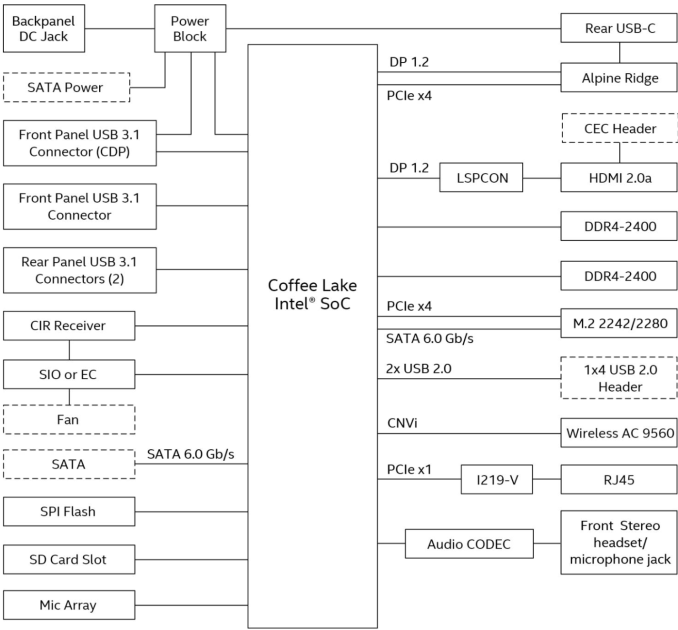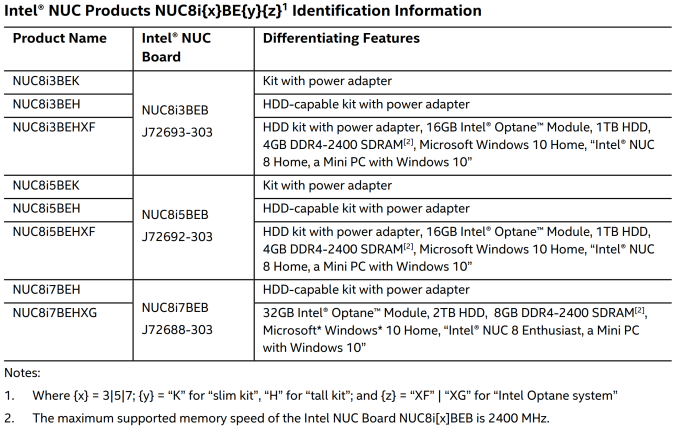Intel's Bean Canyon NUCs have been subject to a number of leaks, notably from FanlessTech. However Intel has finally made things official with a detailed technical product manual for all the members of the Bean Canyon NUC family. From an I/O perspective, the Bean Canyon NUCs look very similar to the Baby Canyon NUCs. However, the internals have gone in for a significant revamp, thanks to the Coffee Lake processors (CFL-U) inside. The updates include:
- 28W TDP processors across all SKUs, with true quad-core / octa-thread options
- Iris Plus Graphics 655 with 128MB eDRAM across all SKUs
- Intel Wireless-AC 9560 with Bluetooth 5.0 WLAN module
- USB 3.1 Gen 2 (10 Gbps) support on all external Type-A ports
While most of the Baby Canyon NUCs came with a 15W TDP processor - either in a "2+2" or "2+3e" configuration - all the Bean Canyon models (NUC8BE) sport 28W TDP processors (that can be configured to run with a lower TDP of 20W, if needed). The 28W TDP allows all the models to come with Iris Plus Graphics 655 with 128MB of eDRAM as the integrated GPU. This makes "2+3e" CPUs the new baseline, while even more powerful "4+3e" CPUs are now an option.
Since these are U-series processors, the PCH is on-package with the rest of the CPU. The move to the Cannon Point-LP integrated PCH allows for four USB 3.1 Gen 2 ports that are present as Type-A ports in the front and rear of the chassis. The CFL-U come with the new Integrated Connectivity feature (CNVi), where the Wi-Fi and Bluetooth MAC and other functional blocks are put inside the processor. The CRF (companion RF) module completes the Wireless-AC 9560 by implementing the signal processing, RF, and analog functions.
The Intel Wireless-AC 9560 is a significant upgrade over the Wireless-AC 8265 in the Kaby Lake NUCs. It comes with Wave 2 features, including support for 160 MHz channels and downlink MU-MIMO. The 2x2 WLAN module is theoretically capable of 1.73 Gbps bandwidth. It also integrates dual-mode Bluetooth 5 support.
| Intel Bean Canyon NUC PCs (Non-Optane SKUs) | |||||
| NUC8i7BEH | NUC8i5BEH | NUC8i5BEK | NUC8i3BEH | NUC8i3BEK | |
| CPU | Core i7-8559U 4C/8T 2.7 (4.5) GHz 28 W TDP |
Core i5-8259U 4C/8T 2.3 (3.8) GHz 28 W TDP |
Core i3-8109U 2C/4T 3.0 (3.6) GHz 28 W TDP |
||
| Graphics | Intel Iris Plus Graphics 655 | ||||
| PCH | Intel Cannon Point-LP for Coffee Lake-U | ||||
| Memory | Two SO-DIMM slots, up to 32 GB of DDR4-2400 | ||||
| 2.5" bay | 1x2.5"/9.5mm bay, SATA3 | None | 1x2.5"/9.5 mm bay, SATA3 | None | |
| M.2 Slot | Up to M.2-2280 SSD with SATA3 or PCIe 3.0 x4 interface | ||||
| Wi-Fi/BT | Soldered-down Intel Wireless-AC 9560(802.11ac 2x2 + BT 5.0) with WiDi support | ||||
| Ethernet | Intel I219V Gigabit Ethernet controller | ||||
| Display Outputs | DisplayPort 1.2 via USB-C connector HDMI 2.0 |
||||
| Audio | 3.5 mm TRRS audio jack 7.1 channel audio output via HDMI or DP |
||||
| Thunderbolt & USB-C |
1x Thunderbolt 3 Type-C (40 Gbps) (USB 3.1 Gen 2 and Display Port functionality included) | ||||
| USB | 4 USB 3.1 Gen 2 Type-A (10 Gbps), one with charging | ||||
| Other I/O | MicroSDXC card reader with UHS-I support One infrared receiver |
||||
| Size (mm) | 115 × 111 × 51 | 115 × 111 × 31 | 115 × 111 × 51 | 115 × 111 × 31 | |
| PSU | External, 65 W | ||||
Intel continues to use a LSPCon on board to convert the Display Port 1.2 output of the processor to a HDMI 2.0 port with HDCP 2.2. Unfortunately, stereoscopic 3D will not be supported. The good news is that the Thunderbolt 3 USB Type-C port on all the models will also support 4Kp60 displays with HDCP 2.2. All versions of the Bean Canyon will support Thunderbolt 3 (unlike the Core i3 version of the KBL-U Baby Canyon that restricted the Alpine Ridge Type-C port to USB 3.1 Gen 2 only in the firmware).
Similar to the previous NUCs, Intel plans to sell both kit (NUC8iXBEK / NUC8iXBEH) and board versions (NUC8iXBEB) of the different configurations. Note that the BEK does not support a 2.5" drive, while the BEH SKUs do. System builders using the BEB SKUs can opt to operate the processor in the cTDP down (20W) mode if adequate cooling is not available. Intel also plans to offer pre-built systems with Optane, as described below.
Retail availability is expected to be in early August. Pricing details are yet to be made available.
from AnandTech https://ift.tt/2JPXUxH
via IFTTT






No comments:
Post a Comment